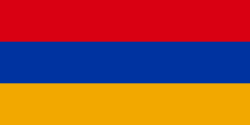Armenians
 | |
| Total population | |
|---|---|
c. 7[1]–10 million[2]
 | |
| Regions with significant populations | |
| 1,182,388[5]–2,900,000[6] | |
| 1,000,366[7]–1,500,000[8] | |
| 250,000[9]–750,000[10] | |
• | 168,191[11] 41,864[12] |
• | 146,573[13] |
| 150,000[14] | |
| 120,000[15] | |
| 90,000–110,000[16] | |
| 100,000[17] | |
| 100,000[18] | |
| 100,000[19][20] | |
| 80,000[21] | |
| 70,000[22] | |
| 60,000[23] | |
| 55,740[24] | |
| 50,000[25] | |
| Languages | |
| Armenian | |
| Religion | |
| Christianity Armenian Apostolic Church · Catholic · Protestant Armenian Native Faith | |
| Related ethnic groups | |
| Hemshin, Cherkesogai, Hayhurum, Armeno-Tats, Hidden Armenians | |
Armenians (Armenian: հայեր, hayer [hɑˈjɛɾ]) are an ethnic group native to the Armenian Highlands of Western Asia.[26]
Armenians constitute the main population of Armenia and the de facto independent Artsakh. There is a wide-ranging diaspora of around 5 million people of full or partial Armenian ancestry living outside modern Armenia. The largest Armenian populations today exist in Russia, the United States, France, Georgia, Iran, Germany, Ukraine, Lebanon, Brazil, and Syria. With the exceptions of Iran and the former Soviet states, the present-day Armenian diaspora was formed mainly as a result of the Armenian genocide.[27]
Armenian is an Indo-European language.[28] It has two mutually intelligible spoken and written forms: Eastern Armenian, today spoken mainly in Armenia, Artsakh, Iran, and the former Soviet republics; and Western Armenian, used in the historical Western Armenia and, after the Armenian genocide, primarily in the Armenian diasporan communities. The unique Armenian alphabet was invented in 405 AD by Mesrop Mashtots.
Most Armenians adhere to the Armenian Apostolic Church, a non-Chalcedonian Christian church, which is also the world's oldest national church. Christianity began to spread in Armenia soon after Jesus' death, due to the efforts of two of his apostles, St. Thaddeus and St. Bartholomew.[29] In the early 4th century, the Kingdom of Armenia became the first state to adopt Christianity as a state religion.[30]
Etymology

The earliest attestations of the exonym Armenia date around the 6th century BC. In his trilingual Behistun Inscription dated to 517 BC, Darius I the Great of Persia refers to Urashtu (in Babylonian) as WIKI
